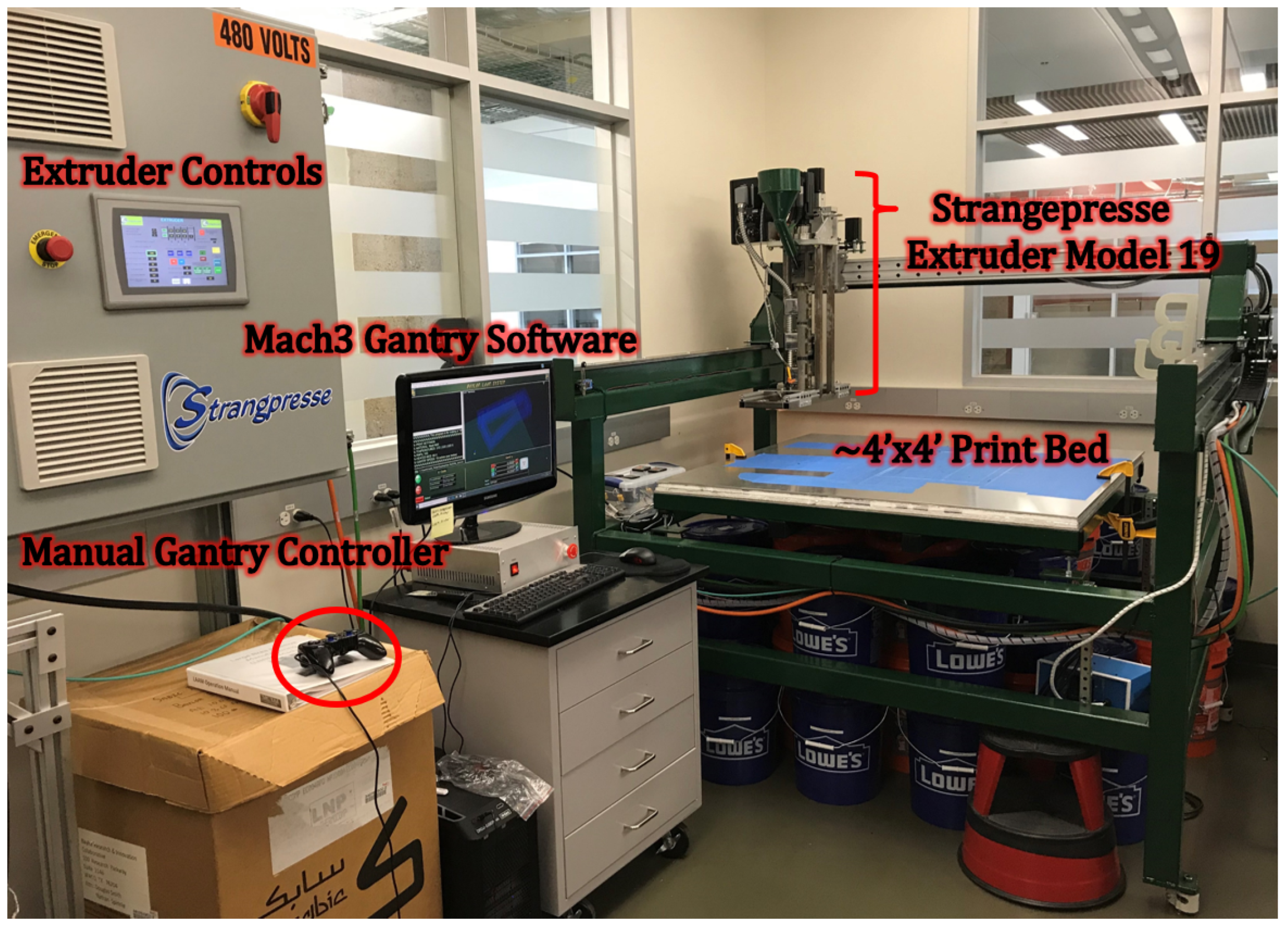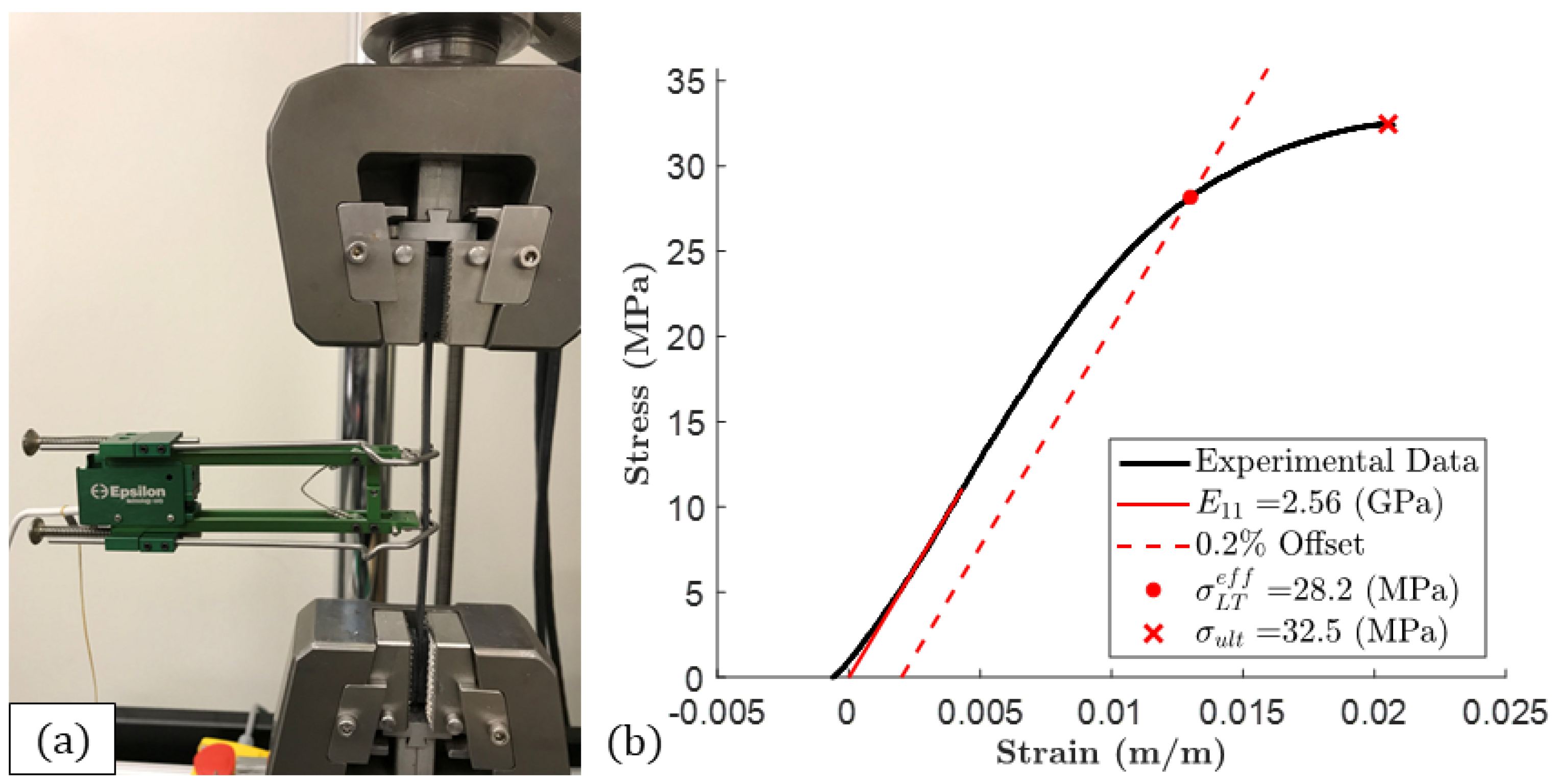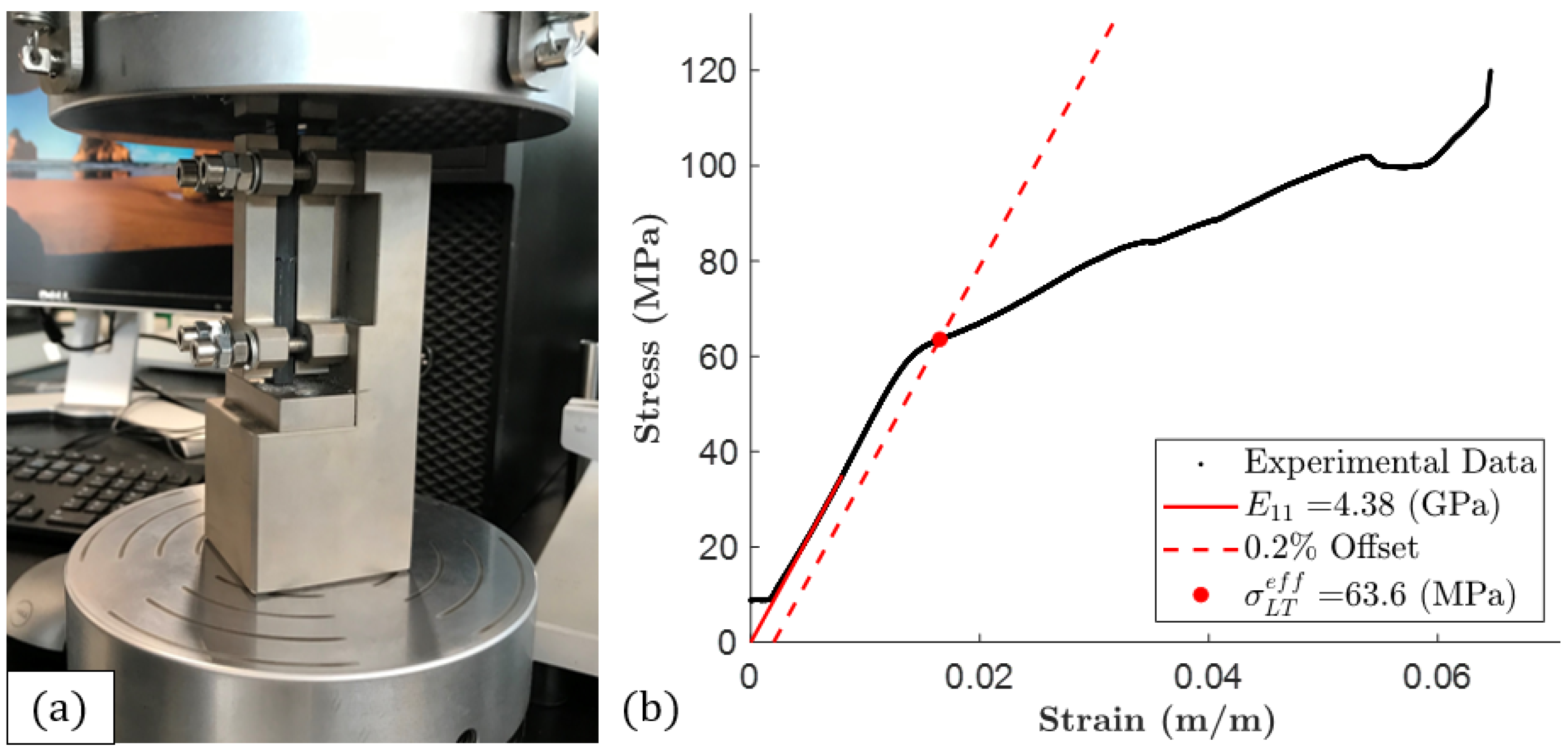4.1. Fiber Orientation Kinematics
Over the past few decades there has been considerable work in the area of fiber motion kinetics and the resulting structural performance of the processed composite. The following section pulls together a summary of the high points along with various components that were used in the present study. Consider a fluid flow domain with the velocity profile
v(
x) and velocity gradients
L(
x), where
x denotes position. Jeffery’s foundational work in expressing fiber motion for a dilute suspension in such a domain describes the time rate of change in orientation of a single, rigid, inertialess ellipsoid [
2],
In the above equation, the material derivative of the unit vector
p, which points along the long axis of the fiber, is used. That is,
. In addition, the vorticity tensor is defined as
, and the rate of deformation tensor is similarly defined as
.
ξ is the fiber geometric term, which allows Equation (
5) to be used for other axisymmetric shapes besides ellipsoids as long as an equivalent ellipsoidal aspect ratio,
, is properly defined. Expressing the fiber geometric term
ξ in terms of
gives (see, e.g., [
15])
Jeffery’s equation as expressed in Equation (
5) may be used in dilute fiber solutions, but a fiber interaction model must be used for concentrated solutions. The concentrated regime may be defined as
, where
is the fiber volume fraction and
d and
L are the fiber diameter and length. For the carbon fibers in the CF-ABS used in the present study
6.4 μm/278 μm = 2.3%. The CF-ABS used in the present study had
(this corresponds to a 13% weight fraction) and 8.11%
2.3%, thus the CF-ABS flow was considered concentrated and therefore a fiber interaction model was used. In addition, the orientation tensor approach popularized by Advani and Tucker [
3] was used to describe the orientation state of a population of fibers and save orders of magnitude in computational time. Cast in terms of orientation tensors, there are multiple options for the proper characterization of the fiber interaction kinetics, such as the retarding principal rate model from Tseng et al. [
16], the interaction coefficient approach of Folgar and Tucker [
4], and the anisotropic rotary diffusion model of Phelps and Tucker [
6]. In the present study, we focused on the fiber interaction model of Wang et al. [
5],
where the second- and fourth-order orientation tensors, as discussed by Advani and Tucker [
3], are defined as
In the above,
is the orientation probability density function. In addition,
κ is the slowness factor as discussed by Wang et al. [
5],
is the fiber interaction constant introduced by Folgar and Tucker [
4],
is the scalar magnitude of
D,
,
, and
and
are the
ith eigenvalue and eigenvector of
A. Based on the work of Bay and Tucker [
17], we take
Note, that
is the geometric fiber aspect ratio (
) and is related to the equivalent ellipsoidal aspect ratio of a cylindrical fiber as given by Zhang et al. [
15].
Furthermore, based upon earlier work by the present authors (see, e.g., [
8]), a value for the slowness parameter of
was selected. Finally, the eigenvalue-based orthotropic closure discussed by Wetzel [
18] and VerWeyst [
19] was used to estimate
due to its accuracy and efficiency. Equation (
7) and all the equations in this section which it depends on were custom-coded by the authors in MATLAB, such that all flow kinematics were performed in the MATLAB environment. This was conducted along several streamlines in the flow domain to capture a fine-resolution solution for the fiber orientation state across the flow domain.
4.2. Fiber Micromechanics
The linear elastic nature of a material is often described using Hooke’s law to relate the stress,
, to the strain,
, through the stiffness,
, or the compliance,
, as
Fibers and matrix have different values for their respective stiffness and due to the length scales considered, an effective stiffness is considered for the composite,
. This effective stiffness, also termed the homogenized stiffness, due to its relationship to the associated underlying unidirectional stiffness tensor of the composite,
, and the fiber orientation distribution function, is expressed as
The underlying unidirectional stiffness tensor of the associated composite
may be found in a variety of methods, the Halpin–Tsai and rule of mixtures often being the most popular due to their ease of implementation. In the present study, the authors used the Tandon and Wang [
20] model with the closed-form solution suggested in Tucker and Liang [
21] and with the mathematical form expressed in Zhang [
22]. The choice of the Tandon and Wang model for the underlying unidirectional stiffness tensor of the associated composite was based upon the results from [
21] in comparison to other available unidirectional composite models. Thus, with knowledge of the underlying stiffness tensor
and the fiber orientation state from Equation (
7), the effective stiffness tensor at a point could be computed. Advani and Tucker [
3] provided a mathematical form of the effective stiffness tensor in terms of the orientation tensors as
where the coefficients
can be cast in terms of the underlying unidirectional stiffness tensor
as presented in [
3]. Observe that in Equation (
13), the fourth-order orientation tensor
appears. The same orthotropic closure of VerWeyst [
19] and Wetzel [
18] used in Equation (
7) is also used in Equation (
13).
The Tsai–Wu [
23] model for the onset of failure was used and is expressed in terms of the second-order and fourth-order strength tensors, respectively,
and
, as
In Equation (
14), a contracted notation is used where the index pairs [11, 22, 33, 23, 13, 12] are replaced by [1, 2, 3, 4, 5, 6]. For example, the stress tensor in index notation
can be expressed in contracted notation as
where
. In Equation (
14), the summation convention continues to be used where
. Alternatively, the failure envelope in terms of the contracted strain tensor is
where
and
are, respectively, the contracted second- and fourth-order strength tensors. One can obtain the relationship between the tensors
,
,
, and
as (see e.g., [
23])
where the summations on the indices
o and
p are from one to six, and
is the contracted form of the stiffness tensor discussed in Equation (
13). As discussed in [
8], the strength tensor relationship for the failure envelope can be recast in terms of the underlying unidirectional strength tensors,
,
,
, and
, where the bar indicates the unidirectional composite property, using a homogenization similar to that of the stiffness tensor of Equation (
12) as
For a unidirectional-fiber-reinforced composite with all fibers aligned along the
axis, the unidirectional strength tensors
and
may be expressed in terms of the tensile and compression strengths in the form
where the first subscript of the term
indicates the longitudinal (
L) axis along the fiber or the transverse (
T) axis, and the second subscript indicates a tensile (
T) load or compression (
C) load. For example,
is the experimental transverse strength found from compression loading. In the present study, we assumed the tensile and compression behavior for the transverse load direction of the underlying unidirectional composite was identical,
, where
is the experimentally obtained strength of the matrix. We also assumed the corresponding shear strength of the matrix was found as
. Using the form suggested in [
24], the remaining nonzero terms for
were expressed as
and
. Then, using Equation (
16), the unidirectional strength tensors
and
were obtained. As shown in [
8], the homogenized fourth-order strength tensor was found using an identical form as Equation (
13) in terms of the orientation tensors. The homogenized second-order strength tensor in terms of the second-order orientation tensor and second-order strength tensor of the underlying unidirectional SFRP was found as (see, e.g., [
25])
In the present study, the composite was considered at the edge of failure when the equality of Equation (
17) was satisfied. For simulation purposes, a loading state was imposed on the composite and the following expression was evaluated
where
ϵ is the strain state from the imposed load on the structure. The SFRP is not predicted to fail as long as
. When
reaches one, the SFRP is predicted to fail.
The longitudinal tensile strength
for the unidirectional composite was found using the modified rule of mixtures suggested by Van Hattum and Bernardo [
25] as
where the above expression is only valid when the fiber length,
L, is less than the critical fiber length,
. The fibers in the current study had a typical fiber length of 200–300 μm in the final processed composite structure, whereas the critical fiber length assumed in this study,
mm (taken from [
25]), was much greater than the largest fiber length identified in
Figure 6. The term
is the stress of the matrix at the failure strain of the fiber and is experimentally obtained once the strain at failure for the fiber is known.
The longitudinal compression strength was cast in the form suggested by Hayashi and Koyama [
26] as expressed by Bajracharya et al. [
27]
where
and
are the moduli of, respectively, the fiber and the matrix, and
, where
is the strain at which the matrix yields. The parameter
is expressed in terms of the weight-average length of the fibers,
, and the critical fiber length,
, where
.
It is well known that the presence of porosity in the composite reduces the stiffness and the strength. In the thesis of Nargis [
10], the average void fraction identified in her specimen was 13.84%, a value that was used in this paper. Using the estimation of Zhang et al. [
28] that the knockdown factor for the stiffness and the tensile strength is the same and is a function of the void volume fraction, the effective stiffness,
, and strength,
, were expressed as
where in the present study
was used. Equation (
23) was used to find the effective stiffness values
,
, and
and the effective strength values
,
, and
.
4.4. Structural Simulation
The orientation state at the end of the flow domain,
, shown at the origin on the bottom left of
Figure 9, was taken as the steady-state orientation and was used for all structural simulations. This orientation state was then projected along the direction of printing to form a specimen with an orientation that changed along
but was constant along
. The tensile and compression specimen model domains are shown in
Figure 10. Each domain is of a single deposited bead. The bead subjected to tension or compression is allowed to freely slide in the vertical direction, except in the lower, right corner. That is, the displacement
is zero in the lower, right corner and unconstrained everywhere else. The right edge of the bead is fixed horizontally, i.e.,
, and equal to some static displacement value in the
direction,
δ, on the left edge.
For the applied displacement
δ, the spatially varying strain,
ϵ(
x), was computed from the finite element results along with the surface stresses. The effective stiffness values for tension or compression,
and
, respectively, were obtained by taking the average of the stress divided by the applied strain on the right end of the loaded specimen. Then, using the spatially varying strain values along with Equation (
20), the spatially varying value for
was obtained at every point in the solution domain. If the maximum value for
was less than one, then the applied displacement
δ was increased, whereas if
at any point in the domain was more than one, the applied load was decreased. This process continued until the maximum spatial value for
φ was one, thus suggesting that the member was at the onset of failure. At this point,
and
were calculated. A representative solution is shown in
Figure 11a,b for a displacement resulting in a tensile and compression failure, respectively.
The finite element process described above was extended to study the stiffness and strength response over a range of values for
κ. This first study fixed the fiber length and diameter to be that in the deposited bead, yielding a weight-average fiber aspect ratio of 38.8 as given in
Table 1. The fibers were assumed to be randomly orientated initially for the flow domain of
Figure 9, and once deposited, the structural domain shown in
Figure 10 was analyzed for the stiffness and strength estimates for tension and compression. Using the fiber aspect ratio of 38.8 and a weight fraction of 13% (i.e., a volume fraction of 8.11%), the interaction coefficient from Equation (
9) evaluated to
. The range for
was taken to be 0.05 to 0.2, within the range suggested by Wang et al. [
5]. The remaining modeling inputs in this study are given in
Table 4.
The results for the stiffness and strength parameters as a function of fiber slowness parameter
κ are provided in
Figure 12 for both the scenario when the porosity is neglected and the scenario when the porosity is accounted for in the structural simulations. Notice in
Figure 12 that the tensile and compression stiffness values are graphically indistinguishable regardless of the porosity. This is by construction in the model, as the stiffness response is assumed to be equivalent in tension and compression. Conversely, the compression strength is measurably more than that of the tensile strength. Observe that the stiffness and strength increase as a function of the increasing value of the slowness parameter. This correlates to the increase in the orientation. As the slowness parameter,
κ, increases from zero to one, the rate of alignment increases as well; thus, a higher value of the parameter
κ correlates with a higher value of the alignment along the flow direction, and thus a higher value for the stiffness and strength for fibers that are stiffer and stronger than the surrounding matrix. It is also worth noting the significant reduction in the part performance as a result of porosity. This highlights the importance of accounting for porosity and the need to identify a means to reduce porosity generation in the deposited bead during processing.
The last modeling study focused on the importance of including the reduction in the fiber length in the structural simulations. Taking the three length distributions presented in
Table 1 for the case of the pellet, the extrudate, and the deposited bead, the weight-average length is shown to decrease from 424 μm to 348 μm to 279 μm. Performing the flow simulation with the corresponding fiber aspect ratios, followed by the structural simulations led to the stiffness and strength predictions provided in
Table 5. Observe that by properly including the reduction in the fiber length, there is a reduction of nearly 12% in the stiffness, a reduction of over 30% in the tensile strength, and a reduction of over 14% in the compression strength.

















